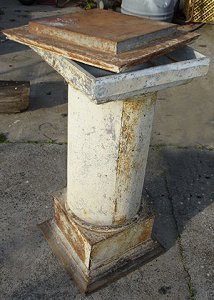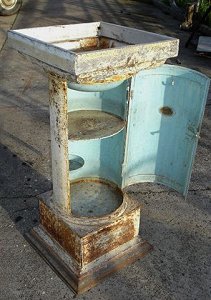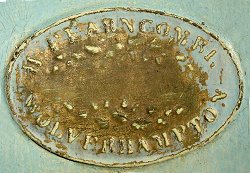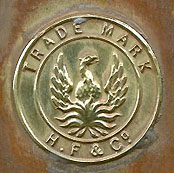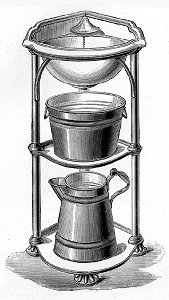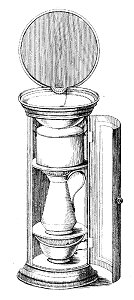|
FEARNCOMBE'S FONT The pioneer spirit in Port Albert, Victoria Wolverhampton exported its products round the world and, naturally, a lot of them went to the colonies, whence came many of our raw materials. And at least one such Wolverhampton item has a curious and interesting history. It is a washstand made by Henry Fearncombe and it has been found in Australia, having been used as a font. The font is now in Port Albert, on the coast of Gippsland on the southern coast of Australia. Fred Wright, who is looking after this artefact, tells us: “The following is what I have been told about the Font. Apparently it was used at St John’s Anglican Church, Port Albert. St John’s church was built in 1863, destroyed by bushfire on 14th Jan. 1884, then the existing church was built in 1885 and opened on the 25th July. When a nearby church was closed, the wooden font from there was then used.
The following is a mention of the font in a book [The Church of Our Fathers, by Albert E Clark] written in 1947 and quoted as written, "The Font is of interest too. It is made of flat iron, the top receptacle having a plug to allow the water to run through. The writer being curious sought to find where it flowed. Sure enough the maker had provided a door in the column, and, inside on a shelf, a jam tin had been placed to catch the water. Inside, too, was a cake of soap and a towel. When it was no longer being used for a font it was stored in the Parish hall until the hall was to be sold and, during the clean out before the sale in about 1983, it was put on a trailer for the rubbish tip. The Priest at the time asked what it was and was told it was an old Font. Luckily he decided it should be kept and he put it in his shed where it stayed until recently, when his widow told the Parish about it after cleaning out the shed.” As to the font itself, Fred says: “ It appears to me to have had a section added to the top to raise the sides; the workmanship does not seem consistent with the rest of its construction. There is a small brass plaque, that has H. Fearncombe's name on it, inside the door. There is also a door in the square base which is hinged at the top.”
Was this originally a font? How and when did it get to Port Albert? There are no records to tell us. There are no catalogues available of Henry Fearncombe’s products but we know he was a prolific maker and tin plate domestic wares as well as other things. His trade was very similar to that of Henry Loveridge, and Loveridge’s catalogue of 1897 has many items of a similar type to this one: and they are all washstands. I have no doubt that originally this font was designed as a washstand. How it got to Port Albert one cannot say. It could have got to Australia as part of an immigrant’s possessions. But one feels it is more likely it was exported there by Fearncombe, who was heavily into the export trade. British exporters to Australia usually started by appointing local agents to distribute their goods and some of them later established their own branches there. It was a good market for Wolverhampton makers and many were represented at all the great industrial fairs, including that at Melbourne in 1880 – though whether Fearncombe was among them has not yet been established.
One way or another this wash stand got to Australia. It seems to be of a fairly sophisticated type and construction and is more likely to date from the end of the 29th century than the middle of it. Port Albert was established in 1840 and thrived, mainly as a port shipping cattle from Victoria to Tasmania, and also as a fishing port. The important town buildings were built quite quickly and, as we have seen, St. John’s church was built in 1863. This font seems a little early for that date – and unlikely to have survived a serious fire. It seems most likely that it was installed in the church in 1885. But why use a washstand as a font? It is hardly likely that there was some mistake. It is much more likely that funds were short and, in the pioneering tradition, one compromised and did one’s best. Some bright fellow saw the washstand, saw it could make a font and with, perhaps, a little alteration to make it more suitable, it was pressed into service. As soon as something better became available the washstand was removed to the parish hall – and maybe used for its original purpose, hence the soap an towel found in it. But by then many Port Albert children had been baptised in it. We tend to think of Australia being a rough and ready place in the last half of the 19th century. In fact cities such as Adelaide and Melbourne, though not existing until the 1830s, were, by the 1870s or 1880s, fully functional cities with all the amenities of any European city. Towns outside the big cities, into the outback, would have given the same appearance on a smaller scale. But they, more than the cities, and still suffering to some extent from the tyranny of distance, were in need of the pioneering spirit of making the most of what you have got, whether it was rainfall or fonts. This washstand-font seems to typify the extraordinary drive and ingenuity that turned Australia from a wilderness into a modern country in the space of only a few decades. This account has been written and compiled by Frank Sharman, mainly from material supplied by Fred Wright, who also supplied the photos of the font. Many thanks to Fred and thanks also to the St. John's Anglican Church, Port Albert; and to Anne Napier, Heritage Adviser to Wellington Shire Council, who drew Frank's attention to this font and put him in contact with Fred.
|
